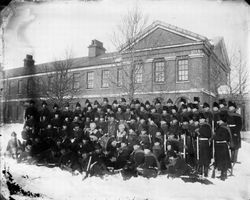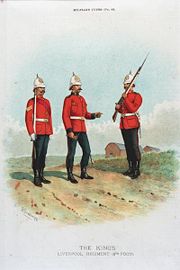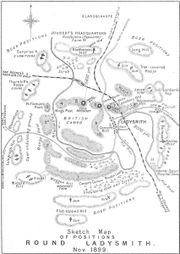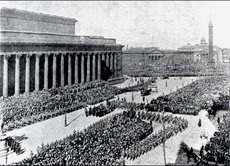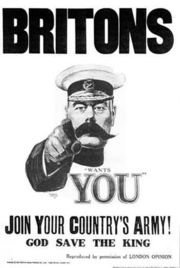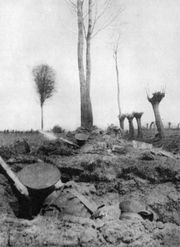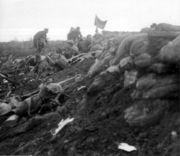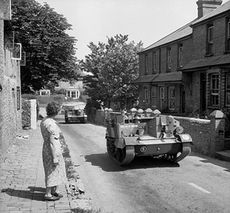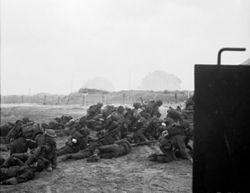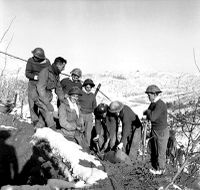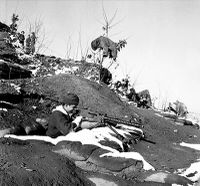King's Regiment (Liverpool)
2008/9 Schools Wikipedia Selection. Related subjects: Military History and War
| The King's Regiment (Liverpool) | |
|---|---|
 Cap badge of the regiment, featuring the White Horse of Hanover |
|
| Active | 1 July 1881- 1 September 1958 |
| Country | United Kingdom |
| Branch | Army |
| Type | Line Infantry |
| Size | Varied; see full list of battalions |
| Regimental Depot | Warrington (1881), Seaforth (1910) |
| Nickname | The Leather Hats, The King's Hanoverian White Horse |
| Motto | Nec Aspera Terrent (Difficulties be Damned) |
| Colours | Blue |
| March | Quick March: Here's to the Maiden Slow March The English Rose |
| Anniversaries | Somme ( 1 July) Blenheim ( 13 August) Delhi ( 14 September) |
| Commanders | |
| Colonel-in-Chief | King George V (c. 1925-1936) |
| Colonel of the Regiment |
Brigadier Richard Nicholas Murray Jones (1957-1958) |
The King's Regiment (Liverpool) was one of the oldest infantry regiments of the British Army, having been formed in 1685 and numbered as the 8th (The King's) Regiment of Foot in 1751. Unlike most British regiments, which were associated with a county, the King's was the city regiment of Liverpool, one of only four regiments affiliated to a city in the British Army After 273 years of continuous existence, the regiment was amalgamated with the Manchesters in 1958.
The King's notably saw active service in the Second Boer War, the two world wars, and the Korean War. Nine Victoria Crosses were awarded to the regiment, the first in 1900 and the last in 1918. An additional two were awarded to Royal Army Medical Corps officer Noel Godfrey Chavasse, who was attached to the Liverpool Scottish during the First World War.
In peacetime, the regiment's battalions were based in the United Kingdom and colonies in the British Empire. Duties varied: riots were suppressed in Belfast, England, and the Middle East; bases were garrisoned in places such as the North-West Frontier Province and West Germany; and reviews and parades conducted throughout the regiment's history.
The regiment has been referred to variously as L'POOL R, the Liverpools, KLR, and the King's. Usage of "L'POOL R" and "the Liverpools" was most prevalent from the 1880s to the 1920s.
Colonial wars (1881-1914)
The Cardwell reforms and Childers reforms from the 1860s to the 1880s substantially reorganised the British Army. Childers reforms principally entailed single- battalion regiments amalgamating to form regiments of multiple battalions. Though the King's remained unamalgamted, the abolition of the numbering system in favour of city or county affiliation affected its title. Thus, on 1 July 1881, the two battalions of the 8th (The King's) Regiment of Foot became the 1st and 2nd Battalions, The King's (Liverpool Regiment). The 8th Foot had been associated with Liverpool since 1873, when the regiment was allocated to the 13th Brigade Depot in Liverpool. Regular regiments gained auxiliary battalions through the integration of the militia and volunteers. Nine militia and volunteer battalions from Lancashire and the Isle of Man transferred to the King's, and ultimately became part of the Special Reserve and Territorial Force. Individual distinctions were retained by these battalions, such as unique titles, cap badges, uniforms, and honorary colonels. Of these, the most overtly individual were the Liverpool Rifles (6th Btn), Liverpool Irish (8th Btn), and Liverpool Scottish (10th Btn).
Under the new system, it was envisaged that one regular battalion would be based in the United Kingdom and one overseas. The 1st Battalion had been located in North West England since the late 1870s. While based in Salford Barracks, Manchester, the battalion was subject to a bomb attack by the Irish Republican Brotherhood ("Fenians"). The barracks sustained minor structural damage as a result of the explosion, which killed a child and badly wounded its mother. Civil disorder during a minesworkers' strike required the intervention of the battalion to quell the riots that had broken out. In 1882, the battalion was posted to Ireland, based in the Curragh. Though the posting was uneventful overall, the battalion was employed after sectarian riots broke out in Belfast following the introduction of the 1886 Home Rule Bill in the British Parliament. The battalion returned to England three-years later.
The 2nd King's overseas service in the 1880s was punctuated by the Third Burmese War, which began in 1885. It had been based on the Indian subcontinent since 1877 and had fought in the Second Afghan War. Invasion of Upper Burma began in October in the form of the Burma Field Force. Making swift progress up the Irrawaddy River, the force captured frontier forts and the capital Myingyan. Following the capital's capture, the battalion provided an escort that oversaw the exile of King Thibaw. A seven-year guerilla campaign against the British followed the completion of Upper Burma's annexation on 1 January 1886. The 2nd King's operated in small groups against the guerillas in the Burmese jungle for over a year. Casualties numbered 12 officers and 256 men by the time the battalion returned to India. The battalion was subsequently posted to Aden for a year before returning to Britain in 1892. Overseas service for the 1st King's included a two-year stay in Nova Scotia, becoming the last battalion of the regiment to garrison Canada. The battalion was posted to the West Indies in 1895, then Natal Colony in 1897. The Second Boer War began two-years later.
Prior to the outbreak of the war, as relations between the British and Boer republics deteriorated, the 1st King's formed a company of mounted infantry and moved to Ladysmith, where it underwent intensive training. War was declared on 11 October and Natal invaded by a Boer force under General Piet Joubert. General George White held authority over 13,000 British personnel dispersed throughout Natal. Heavy losses were incurred by the British in the first major engagements of the war, at Talana Hill and Elandslaagte. Retreat to Ladysmith ensued, where the largest British contingent was concentrated. Having besieged Kimberley and Mafikeng, Boers converged upon Ladysmith and positioned artillery pieces on surrounding hills overlooking the town.
Northern positions occupied by Boers were subjected to an attack ordered by General White on 30 October. White's plans were described as vague, ambitious, and complicated, the battle was ultimately disastrous and became known to the British as "Mournful Monday". The 1st King's were allocated to Colonel Grimwood's column, which was to advance on and secure Long Hill. In the process of their night march towards their objective, the 1st King's, Royal Dublin Fusiliers and a number of mounted infantry companies unintentionally separated from Grimwood's column while following the supporting artillery batteries. Exposed to fire from Lombard's Kop and Pepworth Hill, Grimwood's force became pinned down and required support from Colonel Hamilton's column and French's cavalry. Amidst rumours of an attack against the town being imminent and lack of progress in the battle, White ordered the column to retreat. The Royal Field Artillery provided cover during the chaos that followed, later supported by the King's and elements of the Imperial Light Horse. To the west of Long Hill, at Nicholson's Nek, almost 1,000 soldiers were taken prisoner by the Boers.
Ladysmith was enclosed on 2 November, beginning the 118-day siege. The King's were commanded by Lieutenant-Colonel Llewelyn Mellor and assigned to the north-eastern defensive sector under Colonel Knox, a disciplinarian who instituted a programme of fortification development in his area. Construction of the defences occurred mostly at night. Rain, oppressive heat, and cold provided little opportunity for rest. An attempt by Boers to penetrate the southern perimeter of Ladysmith was repulsed on 6 January, during which the King's mounted infantry contributed to the defence. The scarcity of supplies had become particularly acute by late January. Disease had become rife and the town resorted to consuming the garrison's horses and mules.
Reinforcements had begun to arrive in November under General Redvers Buller. The relief of the three besieged garrisons became the general's priority. He divided his corps and assumed personal command of the Ladysmith expedition. Three successive defeats in December, termed by the British as " Black Week", were followed by further reverses in January and early February. Relief for the beleaguered garrison of Ladysmith arrived on 28 February. The 1st King's were subsequently augmented by a company of Volunteers and its mounted infantry incorporated into an MI battalion. Britain's prosecution of the war extended into the territory of the Orange Free State and Transvaal Republic. On 21 August, at Van Wyk's Vlei, Sergeant Hampton and Corporal Knight were awarded the Victoria Cross for holding their positions and evacuating wounded Kingsmen of the mounted infantry while under heavy fire. Two-days later, the 1st Battalion was attacked while at the forefront of an advance south of Dalmanutha. Their ammunition almost expended and casualties numerous during the protracted engagement, the King's were ordered to withdraw. Casualties were in excess of 70 and Private Heaton was awarded the Victoria Cross.
The nominal annexation of the Orange Free State and Transvaal Republic in May and September respectively did not resolve the war. Instead, the Boer commandos transitioned to guerilla warfare and resisted British occupation until 1902. The King's concentrated in the Eastern Transvaal, where Boers under Botha and Viljoen operated. Detachments were assigned to armoured trains and networks of blockhouses. One such detachment was overwhelmed under controversial circumstance at Helvetia on 29 December. Situated near the Lydenburg- Machadodorp railway, Helvetia was principally garrisoned by a contingent of the King's and contained a 4.7-in gun nicknamed "Lady Roberts". The nocturnal attack, conducted in fog, yielded considerable success for the Boers; scores of prisoners were taken and the gun captured. Only King's Kopje withstood the attack. Major Stapleton Cotton, who ordered the surrender, was sentenced by a general court-martial to be cashiered and dismissed from the army. This decision was considered to be unjust by Arthur Conan Doyle, who contended that the wounds Major Cotton sustained merited "some revision" of the officer's sentence.
The Boer War had provided the first opportunity for the regiment's volunteer battalions to serve overseas with the regular forces, supplying small detachments and service companies for the 1st King's and other units. In contrast, the regiment's militia battalions, numbered the 5th and 6th, were sent to South Africa as intact units late in the war. A monument commemorating the regiment's service in Afghanistan, Burma, and South Africa was erected in St John's Gardens and unveiled by Field Marshal Sir George White on 9 September 1905. The monument was sculpted by Sir William Goscombe John.
World War I (1914-1918)
1914-1915
The regiment fielded 49 battalions during the war from a pre-war establishment of two regular, two militia, and six territorial. Of those 49 battalions, 22 served extensively, receiving 58 battle honours and six Victoria Crosses for service on the Western Front, the Balkans, India, and Russia. Some 13,795 Kingsmen died during the course of the war, the battalions suffering an average of 615 deaths. Thousands more were wounded, sick, or taken prisoner. Of higher formations, the Liverpool Pals sustained nearly 2,800 casualties and the 55th Division's 165th (Liverpool) Brigade, composed entirely of battalions from the King's, had losses of 1,672 dead, 6,056 wounded, and 953 missing during the period of 3 January 1916 and 11 November 1918.
A vigorous recruiting campaign involving pre-war personalities such as Lord Kitchner and Lord Derby facilitated the rapid expansion of the British Army. Territorial units formed duplicate battalions from August 1914 to May 1915. To distinguish them from the originals, they were designated as, for instance, the 2/5th and 3/5th Battalions respectively. Second-line territorial battalions had been raised for home service and recruit training duties, but were ultimately dispatched to the Western Front themselves and replaced by the third-line battalions. Driven by a conviction that the war would not be resolved quickly and seeking an alternative to the Territorial Army, Secretary of State for War Lord Kitchener appealed for an initial 100,000 volunteers who would form a "New Army". The 17th Earl of Derby proposed forming a battalion of "Pals" for the King's Regiment, to be recruited from men of the same workplace. His proposal proved successful. Within a week, thousands of Liverpudlians had volunteered and were eventually formed into the 17th, 18th, 19th, and 20th Battalions. They were known as the City of Liverpool battalions or " Liverpool Pals". Lord Derby addressed recruits on 28 August:
| “ | This should be a battalion of Pals, a battalion in which friends from the same office will fight shoulder to shoulder for the honour of Britain and the credit of Liverpool. | ” |
Mobilisation occurred at the onset of the war in August 1914, at which time the 1st King's was based at Aldershot. Under command of Lieutenant-Colonel W.S. Bannatyne, the 1st King's proceeded to Southampton and embarked aboard the SS Irrawaddy. The battalion landed at Le Havre on 13 August with the 6th Brigade, 2nd Division, one of the original components of the British Expeditionary Force that landed in August. The BEF's first encounter with the German Army at Mons, Belgium, was followed by a retreat that would last until 5 September and end at the Marne, a river east of Paris. Having acted as a rearguard to the 2nd Division, the 1st King's and its brigade were ordered to prevent a German force cutting off the 4th (Guards) Brigade, forming the rearguard at Villers-Cotteréts, and 70th Battery, Royal Horse Artillery. The guns were extricated through the actions of the brigade, earning them praise from the 2nd Division's commanding officer, General Monro.
Paris was saved with the halting of the German advance at the Marne; the ensuing retreat, which prompted an Allied counter-offensive, ended at the Aisne. After both battles were fought, the battalion moved north to Ypres during the so-called " Race to the Sea". In an action at Langemarck during the First Battle of Ypres, the battalion captured the small village of Molenaarelstoek, just north-east of Polygon Wood. As the battle progressed, the Germans sought a decisive victory against the outnumbered BEF and launched the last major assault of the battle on 11 November. Located to the south of Polygon Wood, the 1st King's was one of only a few units available to meet the attack. A composite division of the élite Prussian Guard, advancing in dense formations, was initially successful before it was pushed back after momentum was lost. In the defence of Polygon Wood, the 1st King's held onto their positions, effectively destroying the 3rd Prussian Foot Guards with concentrated rapid-fire and artillery support. By the end of the battle, the 1st King's casualties numbered 33 officers and 814 other ranks (OR) from an original strength of 27 officers and 991 ORs. Among the battalion's dead was the commanding officer, Lieutenant-Colonel Bannatyne, killed by a sniper on 24 October.
By the end of March 1915, eight battalions of the King's were serving on the Western Front. The 1st and 1/5th took part in a "holding" attack designed to support the Allied offensive at Neuve Chapelle. An ineffectual preliminary bombardment failed to destroy large sections of the barbed wire, impeding the 1st King's advance. Heavy casualties were incurred as a result of the withering hail-of-fire directed at the King's, one of whom was the wounded Colonel Carter. One platoon, under Lieutenant Miller, managed to reach the German lines. The platoon blockaded itself in the communications trench and held on for over an hour, under fire from their own artillery, until they withdrew to British lines. In this engagement, the battalion's casualties amounted to 61 killed, 115 wounded, and 62 missing
One month later, on 24 April, a German offensive began the Second Battle of Ypres. "Second Ypres" was the 4th and 1/6th King's first major battle. In the second subsidiary engagement of the offensive, at Saint-Julien, the 4th King's sustained over 400 casualties during a four-day period. The majority, approximately 374, were incurred while supporting the 1/4th Gurkha Rifles on the 27th. The 1/6th, meanwhile, supported the 1st Cheshires in a small defensive action at Hill 60. After the regiment's involvement in 'Second Ypres' effectively ended, four battalions were engaged in battle at Festubert, collectively sustaining over 1,200 casualties. Lance-Corporal Tombs became the regiment's first Victoria Cross recipient of the war for assisting wounded soldiers during the battle. The 1/10th Battalion fought its first battle on 16 June, in a "local" action at Bellewaarde. Losses for the Liverpool Scottish were almost 400 killed, wounded and missing. Of the 24 officers present, only two survived unscathed.
A new British offensive was launched on 25 September at Loos, to coincide with a French offensive in the Champagne region. The King's were represented in the offensive by eight battalions, from standard infantry to pioneers. Chlorine gas was used on the first day of the battle. Strong wind blew the gas backwards, hindering the advance of the 1st King's and others also contending with uncut barbed wire. The 1/9th King's advance also stalled, though they took about 300 Germans prisoner. The battalion was later amongst those who successfully defended against a German counter-attack on 8 October.
1916-1917
The Liverpool Pals' baptism-of-fire came during "The Big Push" on 1 July 1916, on the first day of the Somme Offensive. The four Pals' battalions of the 30th Division were to attack towards Montauban, south of where most of the British Army's casualties (nearly 60,000) were sustained on the first day. The 17th, 19th, and 20th Pals formed the 89th Brigade, under Brigader F.C. Stanley. Their fellow Pals battalion, the 18th, had been detached from the 89th eight-months prior and reassigned to the 21st Brigade. At 07:30, the 30th Division began its advance on the left of the French Corps de Fer. Meeting limited opposition, the Pals completed their objectives with comparatively minimal losses. Grievous losses were, however, incurred by the 18th Battalion when their advance towards the Glatz Redoubt was resisted by heavy machine-gun fire. The battalion's commanding officer, Lieutenant-Colonel E.H. Trotter, killed by a shell on 8 July, detailed his battalion's first-day losses:
| “ | I estimate our casualties at about five hundred. I told both officers and men that there were to be no SOS messages and the [Glatz] redoubt was to be carried by themselves without causing the brigadier to use his reserves, so during the battle the estimates were put at a lower figure than the actual number. | ” |
More battalions entered the fray as reinforcements following the first-day. Some 14 battalions were involved in five attempts to capture the village of Guillemont between July and September. In the early hours of 8 August, the 1st, 1/5th, and 1/8th advanced in conditions that rendered visibility poor. The 1st and 1/8th reached the German front-line trenches and entered the village Their situation deteriorated, however, and the 1/8th's support battalion was driven back by German troops. Contained and isolated by counter-attacks, the 1/8th and three companies of the 1st were surrounded and mostly captured. Losses were considerable in this third attempt; the 1/8th had suffered 15 killed, 55 wounded, and 502 missing, while the 1st lost its commanding officer, Colonel Goff, and sustained 239 casualties. The 1st was later reinforced with drafts from the Manchester Regiment. The village was captured on 3 September, by which time the 12th King's was the regiment's only representative in the struggle for Guillemont.
Preparations for combined Allied offensives in April 1917 were not significantly disrupted when the German Army conducted a strategic withdrawal to the " Hindenburg Line" in northern France. The phased withdrawal, conducted from February to April, reduced the German front by 25-miles To support the ill-fated Nivelle Offensive, British Commonwealth forces were to execute an attack in the Arras area from 9 April. Six of the regiment's battalions were active on the first day of the offensive, of which four were Liverpool Pals. The 13th King's completed their objectives and captured nearly 500 prisoners in heavy fighting near Tilloy-les-Mofflaines, but the Liverpool Pals further south were obstructed by uncut barbed wire. The 18th consolidated in front of the wire until relieved on the 10th, while the 19th and 20th were eventually ordered to withdraw having suffered heavy losses within about 100 yards (91 m) of reaching the wire. Casualties for the King's battalions that participated in the first phase of Arras, referred to as the First Battle of the Scarpe, was in excess of 700.
As the offensive progressed in Arras, the Allies prepared to conduct an offensive in the north, in Flanders. "Third Ypres" (or Passchendaele) was notorious for conditions that reduced the terrain of shell holes and trenches to a quagmire of mud. Ten of the regiment's battalions were active in the initial phase of the offensive, known as the Battle of Pilkem Ridge ( 31 July– 2 August). Six were situated in the Wieltje sector with the 55th Division, north of the Liverpool Pals. Their objectives were identified by three coloured lines: Blue, Black and Green. Progress was difficult and the regiment's battalions suffered heavy casualties. Confusion prevailed during the 18th King's and 2nd Wilts' advance through Sanctuary Wood, carried out in darkness. The three Pals' battalions eventually had to consolidate in front of the 30th Division's initial objective. In the area that the territorial battalions operated, the first and second objectives were overcome. The King's losses accumulated; by the 3rd, the regiment's casualties were in excess of 1,800. The losses of the Liverpool Irish, which operated in a supporting role during the battle, were the heaviest; 18 officers and 304 other ranks.
An account by Captain Wurtzburg, 2/6th Liverpool Rifles, described the conditions endured by soldiers in the Ypres area:
| “ | ...Those who took part in it will never erase from their minds its many ghastly features, among which the mud and the multitude of dead will stand out pre-eminent. Of the former it must be said that the sodden condition of the ground, though it stopped our advance, certainly prevented many casualties from shell-fire, but at the same time many a wounded man was sucked down into the horrible quagmire and stretcher-bearers found their task in many cases beyond their powers. | ” |
1918

The war's end in Europe came with the signing of the Armistice on 11 November 1918. The initial reaction of soldiers was illustrated in the 9th King's battalion history:
| “ | While on parade on the morning of the 11th November it was announced to the men that the Armistice had been signed. The news of the cessation of hostilities was received by the soldiers without any manifestation of the joy or excitement that marked the occasion at home. The parade continued and the rest of the day was spent quite as usual. The news for which the men had waited so long seemed when it came to be almost too good to be true. | ” |
Most of the regiment's battalions were disbanded by the end of 1919, the men demobilised and returned to Britain. Many battalions had stayed on the continent or moved to overseas garrisons prior to disbandment. On 11 December 1918, the remnants of the 1st King's, some veterans of 1914, had marched across the German frontier "at ease", bayonets fixed and their colours uncased. The battalion was based at Düren and Berg Neukirchen for about five-months as part of the British Army of the Rhine. The 13th King's, too, served with the occupation army until disbanded in October 1919.
Inter-war (1918-1939)
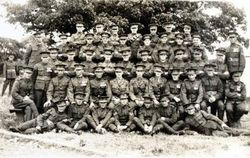
Hostilities did not end for the 17th King's on 11 November; the battalion had sailed for Murmansk, Russia, in October as part of an Allied intervention force sent to fight alongside the "White" forces in their war against the Bolsheviks. The battalion was moved to Archangel, where it was based fully intact for a short period. The battalion's companies served separately for the duration of their stay in Russia. The battalion was disbanded in September 1919.
Inter-war reductions and reorganisations reduced the regiment's territorial battalions from six to one by 1937. The 8th disbanded in the early 1920s, the 9th was absorbed by the Royal Engineers, and a reorganisation of the TA's infantry in the mid-1930s resulted in the 6th, 7th, and 10th converting to new roles. The 6th became Royal Engineers, the 7th joined the Royal Tank Regiment, and the 10th became a battalion of the Queen's Own Cameron Highlanders.
1st King's
As Britain's control of Ireland slipped away in 1920 during the Irish War of Independence, the 1st Battalion was deployed to Bantry, County Cork. The county was a ferment of Republican activity; its supporters were frequently the subject of oppressive measures by British forces to curtail the escalating violence. Compared to other regiments operating in the county, such as the Essex Regiment, the King's had a favourable reputation among its adversaries for their professionalism and humane treatment of prisoners - this saved the lives of some Kingsmen. Their conduct was described by Tom Barry, a prominent IRA leader, as "exemplary in all the circumstances". After the establishment of the Irish Free State in the south, the battalion was moved to Northern Ireland, stationed in Derry and Omagh.
A brief deployment to Turkey as part of the army of occupation occurred in 1923. The battalion returned to England in 1924 and was posted from 1926 to the garrisons in Malta, Sudan, and Egypt. While much of the battalion's time in Egypt was peaceful and comfortable, they occasionally dealt with rioting, and on one occasion a company was deployed to Jerusalem. In 1931, Greek Cypriots in Cyprus uprised demanding union with Greece. Two companies were sent as reinforcements for the British garrison in October; C Company arrived via eight Vickers Victoria air transports, followed by the sea-transported D Company. India was the battalion's next posting, based initially in Jubbulpore from 1932. The battalion was moved to Landi Kotal, Khyber Pass, in 1937. Service in the volatitle North-West Frontier Province continued into the Second World War.
2nd King's
The 2nd Battalion continued to serve in India following the Armistice, and in 1919 was called upon for service in the Third Afghan War. Leading a "Special Column", the battalion reached the Toba Plataeu, some 8,000 feet (2,400 m) high, but the war was concluded before the battalion could engage Afghan forces.
Demobilisation followed and the remnants joined the Sudan garrison in 1920, where the battalion was reformed. Postings to Hong Kong and Canton occurred in 1922, then a return to India in 1924. and finally Iraq the following year. Stationed near Baghdad, their stay lasted two-years, uneventful but with the distinction of being the last British battalion to serve there until the Second World War.
Immediately after their return to England, the 2nd King's became the first battalion of the regiment to undertake public duties at Buckingham Palace. The battalion was based in various parts of the country for nearly a decade before resuming overseas duties in 1938, when it was posted to Gibraltar.
World War II (1939-1945)
Expansion was on a more modest scale to that which occurred during the previous world war. Ten battalions were raised between 1939 and 1940, including the reformed 8th (Irish). Two of these war-raised battalions converted to armour and anti-air roles in 1941; the 11th becoming the 152nd Regiment, RAC, and the 12th transferring the Royal Artillery as the 101 Light Anti-Aircraft Regiment. Some 16 battalions and four batteries of the Home Guard were affiliated with the King's Regiment. The Lancashire Home Guard performed various duties in Britain supporting the Civil Defence Service and regular army, and served during the Liverpool Blitz.
By late-1941, three battalions of the regiment (1st, 2nd, and 13th) were stationed abroad. The remainder were located throughout the United Kingdom, poised to defend against an invasion. The 1st and 13th would serve in Burma as Chindits, the 2nd in Italy and Greece, and the 5th and 8th in North-West Europe. Of battalions that had transferred and converted to other roles pre-war, only the 40th RTR (7th King's) saw active service. With the 23rd Armoured Brigade, the 40th RTR fought in North Africa, where they acquired the nickname "Monty's Foxhounds", Italy, and Greece.
Italy and Greece
Having spent five-years in Gibraltar, the 2nd King's departed for Egypt in December 1943 to reinforce the 4th Infantry Division. The battalion landed in Italy with the division in March 1944. On 11 May, the division conducted an opposed crossing of the Rapido River during the final battle for Monte Cassino. The 2nd King's constituted, along with the 2nd Somersets, the main element of 28 Infantry Brigade's initial assault. Behind schedule by 35-minutes and consequently lacking artillery support, the battalion attempted to cross the Rapido under heavy mortar and artillery fire. Many boats capsized as a result of the strong current and casualties were numerous. The 4th Division collectively struggled to consolidate its bridgehead. A determined defence and minefields inflicted heavy casualties on the King's and their commanding officer, Lieutenant-Colonel Garmons-Williams, was mortally wounded. Depleted and disorganised, the remnants of the bridgehead were withdrawn on the 14th. The 2nd King's had, by then, lost 72 men killed or missing and many wounded.. After a five-month struggle, Monte Cassino was captured on 18 May by the Polish II Corps and the Gustav Line broken.
The Allies captured Rome in June and the King's fought in the subsequent advance to the Trasimene Line. Intense battles were fought in the Gioella area and Tuori, the latter earning the regiment a unique battle honour in the British Army. In about nine-months of service, in difficult, mountainous terrain, with heavy casualties, the battalion was awarded four DSOs, nine MCs, three DCMs, four MMs, and six mentioned in despatches. Among those awarded were Sergeant Welsby, who single-handedly secured a fortified farmhouse, and Major J. A. de V. Reynolds, for his leadership and conduct around Casa Arlotti.
Conflict in Greece between government forces and Communist partisans followed the vacuum created by Germany's withdrawal. The partisans ( ELAS) sought to establish themselves as the country's new political authority and had captured significant territory in the Attica region. The 4th Division was redeployed in December to reinforce the British forces embroiled in a civil war. Flown to Piraeus on 12 December, the 2nd King's were directed to engage partians within 24-hours of their arrival. In a brief action, the battalion seized barracks occupied by partisans at the cost of 14 casualties. There were numerous instances of house-to-house and street fighting in Athens during the battalion's seven-week internal security employment. The city was cleared of insurgents by early January 1945. A ceasefire was agreed upon and the King's remained for a year to support the maintaining of a tense peace before leaving for Cyprus.
Burma
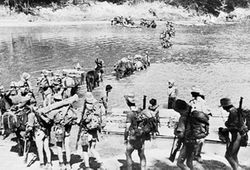
The 13th King's sailed for India in December 1941, coinciding with Japan's entrance into the war. Intended for garrisson duties, the battalion's strength contained many men who were of an old or medically downgraded condition. After Burma was occupied by Japan in 1942, a unit was formed to penetrate deep behind Japanese lines from India. The 13th King's provided the majority of the British contingent for the unit, which was designated as the 77th Indian Infantry Brigade (the ' Chindits') and commanded by Orde Wingate.
Organised into two groups, the Chindits' first operation (codenamed Longcloth) began on 8 February 1943. No. 2 Group, commanded by Lieutenant-Colonel S.A. Cooke, was formed from the 13th King's and divided into five independent columns, two of which (Nos 7 and 8) were commanded by majors from the battalion. No Japanese opposition was encountered initially, allowing the Chindits to cross the Chindwin River and advance into Burma unimpeded.
Normandy and Germany
In 1943, the 5th and 8th King's (Liverpool Irish) were provided with speciailst training at Ayrshire in preparation for a planned invasion of France. They were selected to form the nucleus of the 5th and 7th Beach Groups, whose objectives on an invasion beach were to maintain organisation, secure positions, and provide defence against counter-attack.
As invasion neared in mid-1944, the two battalions were moved from their camps to ports in southern England and embarked aboard troopships and landing ship tanks. Much of the Liverpool Irish embarked aboard the Ulster Monarch, a passenger ship that had served on the Belfast-Liverpool line before the war. After delays, the invasion fleet proceeded to Normandy on 5 June. Both King's battalions landed on D-Day, the 5th at Sword with the British 3rd Infantry Division and the Liverpool Irish at Juno with the Canadians.
Two companies of the Liverpool Irish landed in the assault wave with the Royal Winnipeg Rifles. Under intense machine gun and mortar fire, the landing of Major Max Morrison's "A" Company proceeded well, allowing some to establish a command-post upon reaching the sand dunes. In contrast, in "B" Company's sector, the late arrival of the reconnaissance party and DD tanks exposed the landing infantry to heavy machine gun fire. The company's officer commanding, Major O'Brien, and the second-in-comannd were among those wounded. Experiences at Sword Beach were similar. As the 3rd Division moved inland, the 5th King's attempted to neutralise hostile positions and snipers. Casualties included Lieutenant-Colonel D. H. V. Board, killed by a sniper, and the OC of 9 Platoon, Lieutenant Scarfe, mortally wounded in an attack on a German position.
Under fire, the beach groups collected the wounded and dead, located and marked minefields, attempted to maintain organisation, and directed vehicles and troops inland. The two battalions operated with the beach groups for a further six weeks. While the depleted Liverpool Irish was disbanded in August, much of its strength having been transferred to other units as reinforcements, the 5th King's was reduced to cadre strength. Disbandment was only avoided through the determination of Lieutenant-Colonel G.D. Wreford-Brown, who argued that the 5th Battalion was nearly the most senior unit active in the Territorial Army.
After the Allies began their advance into Nazi Germany in February 1945, the Supreme Headquarters Allied Expeditionary Force (SHAEF) formed dedicaed units to secure important objectives - equipment, installations, intelligence, and personnel. The 5th King's provided the nucleus for one such T (Target) Force. Elements of the 5th King's reached the naval port of Kiel in May 1945, securing the cruiser Admiral Hipper and taking 7,000 German sailors prisoner. The battalion continued to conduct intelligence operations until July 1946, when it was disbanded during the demoblisation process. Reconstitution into the Territorial Army followed in 1947 under the command of Lieutenant-Colonel Edward John Stanley (later the 18th Earl of Derby).
Post-World War II (1945-1958)
The 1st King's, still roled as parachute infantry, remained in India with responsibility for the area around Meerut, north-east of New Delhi. After reconverting to the infantry role, the battalion departed for Liverpool in late 1947. Meanwhile, the 2nd King's were deployed to Palestine for two-weeks. First arriving on 29 April 1948, the battalion carried out security duties just prior to the establishment of Israel. After returning to Cyprus, the battalion proceeded to Liverpool. On 6 September 1948, the two battalions amalgamated in a ceremonial parade attended by honorary Colonel of the Regiment, Major-General Dudley Ward. The battalion was posted to West Germany shortly afterwards and moved to Spandau, West Berlin, in 1950.
Korean War
The battalion was ordered to Korea in June 1952. By then, the Korean War had entered a period of stalemate, with trench warfare prevailing. At Liverpool, the battalion embarked aboard the troopship Devonshire for Hong Kong, where it underwent training before landing at Pusan, Korea, in September. Replacing the 1st Royal Norfolk Regiment in the 29th Infantry Brigade, 1st Commonwealth Division, the 1st King's took up defensive positions upone moving to the frontline.
Much of the battalion's time at the front was quiet, though their night patrols often resulted in clashes with Chinese troops. The battalion was withdrawn to reserve for three months in 1953. A tactically important feature known as "The Hook", a crescent shaped ridge, was the scene of intense heavy fighting between Commonwealth forces and the Chinese in May. On the night of 20 May, Chinese forces commenced a sustained bombardment of the Hook, defended by the Duke of Wellington's Regiment. A company of the King's was ordered to conduct a nighttime diversionary raid on Chinese positions known as "Pheasant" two-days later. Second-Lieutenant Caws' 5 Platoon, intended to execute the actual attack, inadvertently stumbled upon an unchartered minefield, suffering 10 wounded from a strength of 16. The attack was consequently abandoned, forcing the company to withdraw with its wounded back to British lines.
The King's moved onto the right sector of the Hook on 27 May, while "D" Company's 10 Platoon and "B" Company (as reserve) were attached to the Duke of Wellington's Regiment. The battle began on 28 May, when a heavy bombardment targeted positions held by the Dukes at 7:53 pm. The first wave of Chinese troops was launched against the Duke's positions minutes later, followed by three further waves. Two platoons of the King's were moved forward to reinforce the Point 121 position, which was then attacked by two companies of Chinese infantry. After the attack was repulsed with the assistance of Commonwealth artillery, the Chinese directed their attention to the King's on Point 146. Before the attack began, however, an artillery bombardment destroyed the Chinese formation while it assembled. Fighting continued until the remaining Chinese troops were cleared from positions at approximately 03:30 am.
The 1st King's left Korea for Hong Kong in October, by which time its casualties numbered 28 dead and 200 wounded. Of some 1,500 men that served with the battalion in Korea, 350 were regular soldiers, the rest were national servicemen. The King's moved to Britain in 1955, were posted to West Germany the following year, and made its final return home in 1958.
Amalgamation
The 1957 Defence White Paper (known as the "Sandys Review" after Secretary of State for War Duncan Sandys) announced, among others, reductions in the British Army's overseas responsibilities and the abolition of national service. Regiments and other units were resultingly rationalised through amalgamation or disbandment. The decision to merge the King's and Manchesters was announced to the dismay of many serving and retired personnel. Both, however, shared an historical connection through the 63rd (West Suffolk) Regiment of Foot, constituted as the 8th Foot's second battalion in 1756 and redesginated the 1st Battalion, Manchester Regiment in 1881.
In June, at Brentwood, the colours of the two regiments were paraded for the last time in the presence of Queen Elizabeth, The Queen Mother. The King's Regiment (Manchester and Liverpool) formally came into being on 1 September 1958. On 1 July 2006, the successor regiment amalgamated, joining with two others to form the Duke of Lancaster's Regiment (King's, Lancashire and Border).
The surviving territorial battalion of the King's (Liverpool), the 5th, retained its identity until reduced to "B" Company, Lancastrian Volunteers in 1967. The lineage of 5th King's has been perpuated by "A" Company since its formation in 1992. The company became an integral component of the 4th Battalion, Duke of Lancaster's Regiment in 2006. Contained within the company is the Liverpool Scottish Platoon.
Victoria Cross recipients
| Name | Battalion | Date | Location of deed |
|---|---|---|---|
| Harry Hampton | 2nd | 21 August 1900 | Van Wyk's Vlei, South Africa |
| Henry James Knight | 1st | 21 August, 1900 | Van Wyk's Vlei, South Africa |
| William Edward Heaton | 1st | 23 August, 1900 | Geluk, South Africa |
| Joseph Harcourt Tombs | 1st | 16 May 1915 | Rue du Bois, France |
| Edward Felix Baxter | 1/8th (Irish) | 17/ 18 April 1916 | Blairville, France |
| Arthur Herbert Procter | 1/5th | 4 June 1916 | Ficheux, France |
| David Jones | 12th (Service) | 3 September, 1916 | Guillemont, France |
| Oswald Austin Reid | 2nd | 8/ 10 March 1917 | Dialah River, Mesopotamia |
| Jack Thomas Counter | 1st | 16 April 1918 | Boisieux St. Marc, France |
Battle honours
- Blenheim, Ramillies, Oudenarde, Malplaquet, Dettingen, Martinique 1809, Niagara, Delhi 1857, Lucknow, Peiwar Kotal, Afghanistan 1878-80, Burma 1885-87, Defence of Ladysmith, South Africa 1899-1902
- The Great War: Mons, Retreat from Mons, Marne 1914, Aisne 1914, Ypres 1914 '15 '17, Langemarck 1914 '17, Gheluvelt, Nonne Boschen, Neuve Chapelle, Gravenstafel, St Julien, Frezenberg, Bellewaarde, Aubers, Festubert 1915, Loos, Somme 1916 '18, Albert 1916 '18, Bazentin, Deville Wood, Guillemont, Ginchy, Flers-Courcelette, Morval, Le Transloy, Ancre 1916, Bapaume 1917 '18, Arras 1917 '18, Scarpe 1917 '18, Arleux, Pilckem, Menin Road, Polygon Wood, Poelcappelle, Passchendaele, Cambrai 1917 and 1918, St. Quentin, Rosières, Avre, Lys, Estaires, Messines 1918, Bailleul, Kemmel, Bethune, Scherpenberg, Drocourt-Queant, Hindenburg Line, Epehy, Canal du Nord, St Quentin Canal, Selle, Sambre, France and Flanders 1914-18, Doiran 1917, Macedonia 1915-18, NW Frontier, India 1915, Archangel 1918-19, Afghanistan 1919
- The Second World War: Normandy Landing. North-West Europe 1944, Cassino II, Trasimene Line, Tuori, Capture of Forli, Rimini Line, Italy 1944-45, Athens, Greece 1944-45, Chindits 1943, Chindits 1944, Burma 1943-44
- The Hook 1953, Korea 1952-53
